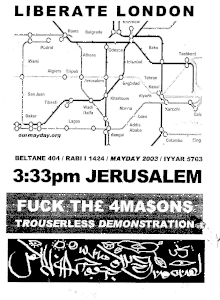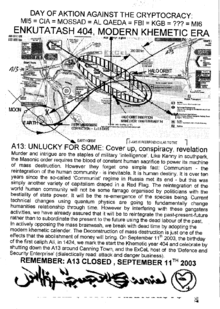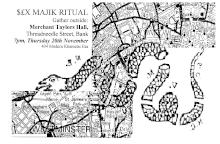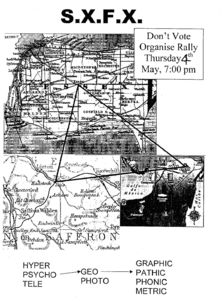Sunday, November 30, 2014
Premium Bundle >> BronxArtSpace > Claudia Hart > submit work
Ive shown here in the past- Looks like Claudia Hart and some other digital greats will be showing there.
Anyone interested in putting together a group show of class work?
They would probably show the works which fall into the "art" category....
www.bronxartspace.com
Premium Bundle is a compilation of artworks based on or inspired by the internet. The 2014 collection curated by Claudia Maté includes the artists: Ivana Basic, Ryder Ripps, Lorena Prain, Elliott Wright, Rollin Leonard, Mattie Hillock, Emilio Gomariz, Kim Asendorf, Ole Fach,Sabrina Ratte, Sara Ludy, Claudia Hart, Vince Mckelvie, Chris Shier, Claudia Maté and Anthony Antonellis. Comprised of sculptures, paintings, videos and interactive artworks, the group will come alive on December 12th.
If you would like to submit work for a future show, email us at art@bronxartspace.com with information about your submission; links, images, etc. Video should be submitted as a video file, Vimeo, or YouTube link.
Synthetic Zero / BronxArtSpace
305 E 140th St #1A
Bronx, NY 10454
(646) 327-8281
art@bronxartspace.com
DIRECTIONS:
The art space is at 305 E. 140th St., #1A, Bronx NY 10454.
We're about 20 minutes from Union Square. From Manhattan, 4-5 train to 125th, transfer to 6, one stop to 3rd Ave/138th St, it's 2 blocks from there. Note there are two exits at 3rd Ave/138th, one at Alexander Ave and one at 3rd Ave. Ring 3A or 1B if 1A does not answer.
Anyone interested in putting together a group show of class work?
They would probably show the works which fall into the "art" category....
www.bronxartspace.com
Premium Bundle is a compilation of artworks based on or inspired by the internet. The 2014 collection curated by Claudia Maté includes the artists: Ivana Basic, Ryder Ripps, Lorena Prain, Elliott Wright, Rollin Leonard, Mattie Hillock, Emilio Gomariz, Kim Asendorf, Ole Fach,Sabrina Ratte, Sara Ludy, Claudia Hart, Vince Mckelvie, Chris Shier, Claudia Maté and Anthony Antonellis. Comprised of sculptures, paintings, videos and interactive artworks, the group will come alive on December 12th.
If you would like to submit work for a future show, email us at art@bronxartspace.com with information about your submission; links, images, etc. Video should be submitted as a video file, Vimeo, or YouTube link.
Synthetic Zero / BronxArtSpace
305 E 140th St #1A
Bronx, NY 10454
(646) 327-8281
art@bronxartspace.com
DIRECTIONS:
The art space is at 305 E. 140th St., #1A, Bronx NY 10454.
We're about 20 minutes from Union Square. From Manhattan, 4-5 train to 125th, transfer to 6, one stop to 3rd Ave/138th St, it's 2 blocks from there. Note there are two exits at 3rd Ave/138th, one at Alexander Ave and one at 3rd Ave. Ring 3A or 1B if 1A does not answer.
Make Up Class
For the makeup class I would like to meet with people 1 on 1. You can meet me in my office or by Skype.
If you have tech problems please describe them in detail in a Google doc and share it with me. I am creating a doodle with meeting times. If you have tech issues choose times at the end of the week so I can look into them before we meet.
The meetings will be 30 - 45 mins. The meeting will focus on your final project, video documentation [required], and or 5 page paper. If necessary you can meet more than once for additional help. I am sending the doodle time sheet to your NYU email. Please look and choose a time.
If you have any thoughts or concerns please feel free to contact me.
Thanks!
Mark
If you have tech problems please describe them in detail in a Google doc and share it with me. I am creating a doodle with meeting times. If you have tech issues choose times at the end of the week so I can look into them before we meet.
The meetings will be 30 - 45 mins. The meeting will focus on your final project, video documentation [required], and or 5 page paper. If necessary you can meet more than once for additional help. I am sending the doodle time sheet to your NYU email. Please look and choose a time.
If you have any thoughts or concerns please feel free to contact me.
Thanks!
Mark
Monday, November 24, 2014
Class is Canceledfor today-
Hey guys- Very sorry but I am still really sick....
Lets do a make up for this class-
I think it would be best to meet with everyone one on one and work with you on your project for the make up time. I will post available time slots soon. It will be OK if you want to Skype in. Keep working on your project!
Lets do a make up for this class-
I think it would be best to meet with everyone one on one and work with you on your project for the make up time. I will post available time slots soon. It will be OK if you want to Skype in. Keep working on your project!
Sunday, November 23, 2014
ARNY -- off campus -- Tuesday, November 25, 2014 7:00 PM
ARNY - Augmented Reality New York
Tuesday, November 25, 2014
7:00 PM
7:00 PM
National Arts Club
15 Gramercy Park South
New York, NY 10001
15 Gramercy Park South
New York, NY 10001
Price: $1.00 per person
Possibly out sick >>
Hi Guys,
I've been really sick for the last few days and I might be out sick tomorrow.
Please check this blog tomorrow morning and I will post if class is canceled or a go.
If class is cancelled we will do a makeup.
I've been really sick for the last few days and I might be out sick tomorrow.
Please check this blog tomorrow morning and I will post if class is canceled or a go.
If class is cancelled we will do a makeup.
Saturday, November 22, 2014
Scubus S – The World’s First Augmented Reality Scuba Diving Mask
Scubus S – The World’s First Augmented Reality Scuba Diving Mask

Read Also – Perth Mint of Australia Brings Augmented Reality to Christmas-Coins
But the biggest problem of all for scuba divers is surely underwater communication which is limited to hand sign language and in order to communicate you must be in a constant visual contact. Imagine a scuba diver signaling that he’s out of breath. How do you think can he afford and wait until the fellow diver will pick on that? Or imagine full spectrum of underwater beauty that the diver is constantly want to share, the moments and… “Oops! Just missed it!” All thanks to scuba diver waiting on his fellow scuba diver to react again. Now this is where technology and augmented reality shines and can truly change the experience and empower people underwater.
This is where the scubus S steps in with it’s pre-typed messaging and chat option. But don’t get too excited yet. Unfortunately the Bluetooth, radio waves or any type of wireless tech doesn’t work that good or doesn’t work at all underwater. What this means for you is that chatting underwater will be a little different than endlessly typing on your smartphone in messenger apps. In order for scubus S to work underwater we’re using what the submarines used as means of communication for decades – the acoustic wave which turns out travels underwater even better than on the surface. But it has it’s limitations too. Nonetheless you’ll be equipped with up to 20 pre-typed messages like “Emergency! Help me now!”, “Take a picture of me!”, “Look at me now!” and others with which you’ll communicate with others divers up to 130 f / 40 m deep and approximately 330 f / 100 m in range. You’ll manage group chat and other data of the scubus S via a wrist-worn remote. To compensate for not being able to chat like on a messenger app the scubus S is going to have an HD camera with 12MP photo and 1080p @ 30 fps video as well as LED flashlight.
For more information visit https://www.indiegogo.com/projects/scubus-s-the-world-s-first-ar-scuba-diving-mask
Project Tango Hands-On: Computer Vision Is So Much Cooler Than You Think
Project Tango Hands-On: Computer Vision Is So Much Cooler Than You Think
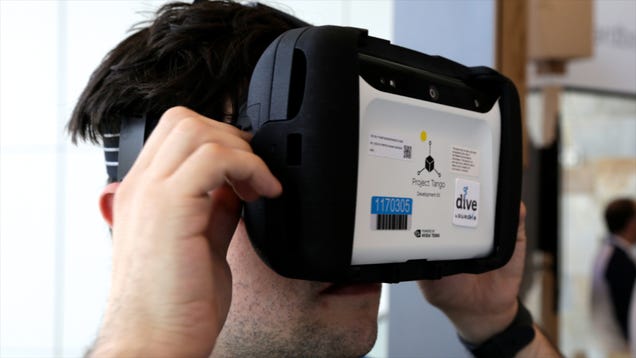 Expand
Expand
Google's
Project Tango tablet can see in 3D, but I didn't really understand why
I, human person, would actually care about the technology beyond an
abstract appreciation of the ideas behind it. Until I strapped one to my
face, with an Oculus Rift-like head mask.
Until I
strapped the mask on, I never believed that Project Tango could be more
than just a concept. At best, I thought, it would end up being a
gimmick, sold to sucker consumers who didn't know how to shop. I was so
wrong.
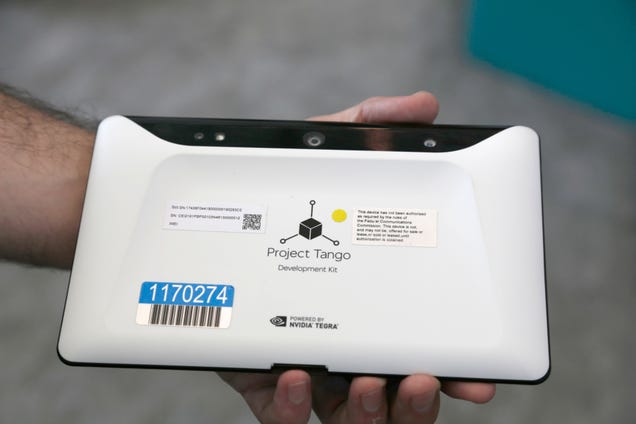 Expand
Expand
Announced earlier this year,
Project Tango wants "to give mobile devices a human scale understanding
of space and motion." It uses a motion-sensing camera, a 3D depth
camera (basically a really sophisticated Kinect), as well as a regular
visual camera. All of the data is pulled in and processed in real-time
by two computer vision processors.
The tablet
version of the hardware uses Nvidia's Tegra K. In the words of one
Google employee, "it's basically the most powerful tablet in the world
right now." And the tech works very well! During Lee's presentation
today, he says that the team has achieved just 1 percent drift when
using the tablets to map complicated spaces by walking around in them.
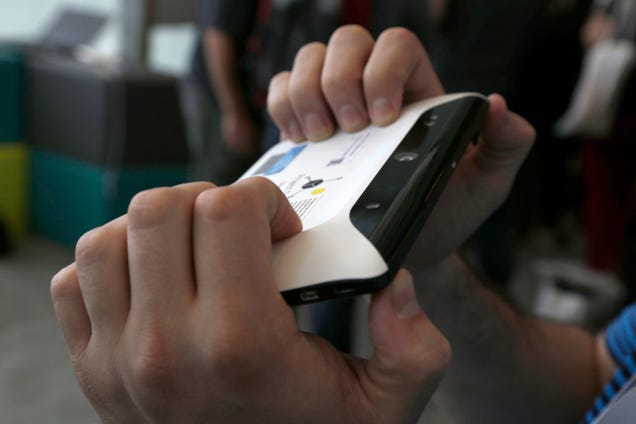 Expand
Expand
But it goes
beyond just developer edition dreams. Project Tango's technical lead
Johnny Lee announced that in addition to the dev-focused tablets, ATAP
is working with LG to make a consumer version for 2015. For normals.
Seriously.
Why would a
regular person ever want to use a Tango device, even if it can see like
a human and fit in your pocket? What does that mean in practical terms?
How does it transcend gimmick status? Today I got my hands on a number
of the apps and tools Google's been working on to explore that very
question.

The one
that made me giggle (joyful, not mocking) the most was an augmented
reality headset built by Durovis. The company already makes a Dive
headset that lets you insert a phone so you can use it for VR
experiences like an Oculus Rift. At Google I/O, though,
Durovis
showed off a prototype developed especially for Project Tango, as well
as a little demonstration app, that overlays an aquarium in front of
your face. Fishes flying around right in front of Google's booth
personnel. You can even move in and out of the water by kneeling and
standing up. It takes all of the 3D gaming and immersive experience
potential of the Oculus Rift but steps it up because it can see the
world in front of you as well. Sure, the application is a little silly,
but it shows you the potential of what's possible with Google Tango used
as a head mounted display.
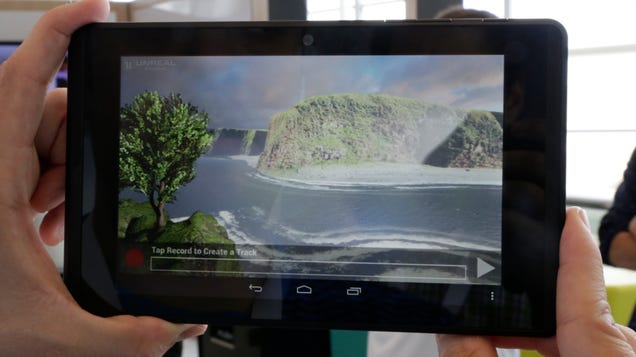 Expand
Expand
It's also an interesting expansion
on the other VR concept Google is showing off at I/O. The simple
concept uses a very basic cardboard design to turn your smartphone into a
VR headset—so it's basically like a Dive made out of cardboard instead
of Dive.
Gaming is
one of the main development focuses for Project Tango team, and they've
gone to lengths to build out a few different gaming experiences as well
as partnering with studios like Epic Games. At I/O, Google showed off a
few sample games, including a zombie killer in which you aim by moving
the tablet around. Killing zombies is fun! But the most compelling
experiences were some relatively empty maps you might find in a 3D
shooter, which use Project Tango's 3D sensing capabilities. When you
take a step forward in real life, the tablet notices you've moved and
moves you inside the map you're looking at. As with the augmented
reality experience above, it adds a new dimension to the the 360 VR you
get from Oculus or Cardboard.
cThen there are more utilitarian applications that let you map the real world in front of you. In one very simple app, you walk to the four corners of a room, and Google Tango rends a very precise SketchUp outline of the space.
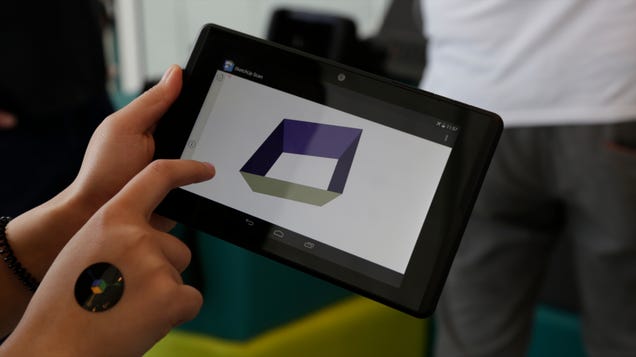 Expand
Expand
In another,
designed by AutoCAD, you can precisely measure and model a room and its
contents so that it's easier to do a little interior designing. No more
going back and forth from the furniture store to measure something over
and over. No more guess how much carpeting you need to buy.
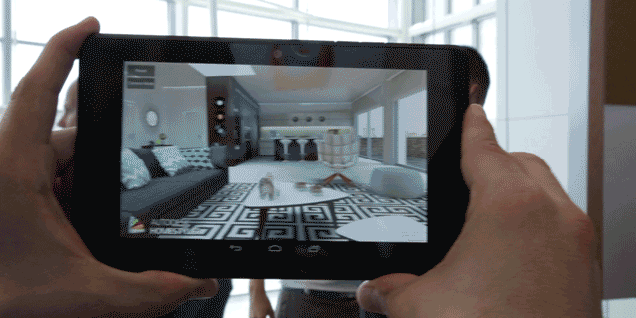
More than
anything else, I was impressed at just how well the technology works.
Some of the real-time rendering in front of you can be a little a choppy
and buggy, but when it comes to the actual measurements that the
technology is making, they're ultra-precise. Project Tango works, and
it's got real-world potential. It just needs some regular people polish
now.
Over the
last month or so I've spoken with several of the partner companies that
actually built the technology that underlies Project Tango about what
exactly Google hoped to do—and what it should do with Project Tango
going forward. According to Farshid Sabet, SVP of Movidius, a company
that makes one of the computer vision processors in the Tango smartphone
from earlier this year, Google really wants to illustrate that the
technology is more than just a professional tool or a wonky concept. And
to make it more than tool for professionals, the software has to work
in a dead simple way, because we're not going to put up with the hiccups
the way a developer or a member of ATAP might.
Today, I
got my first taste of what Google's been cooking up, and I can't wait to
try to whole thing. And what might be most amazing is that it won't be
long before we all get to.
Google Shutsdown Glass Basecamps. Is this the end of Google Glass Project?

When Google Glass project launched, Google started opening up Basecamps. That was back in April 2013 when Google started selling Glass to qualified Glass explorers, but Google Glass became available to the general public in May 2014. There was a total of 4 Basecamps in Los Angeles, San Francisco, New York and London. They offered troubleshoot support, give demos, allowed people to pick up their Google Glass and also meet like minded people to discuss technology. In order to visit one of their Basecamps you has to schedule an appointment but in the past week no more appointments were available to schedule in any of the Basecamps world-wide.
Google is allegedly trying to shut the Basecamps down due to increasing support available online or via phone. Google Glass can also be ordered online and shipped to you the next day via UPS so there is absolutely no need for the customer to travel to one of their Basecamps. In other words, they are no longer that necessary and customer support won’t suffer. Google Glass hasn’t been an instant international success as their Android operating system or other Google products so this might be a sign of Google trying to shut the project down if it is not as profitable as other Google projects. After all, there are only a few things you can do with the Glasses. You have the support for the native Google apps (Google Now, Google +, Google Maps and Gmail) and some 3 party apps (Evernote, Skitch, New York Times and Path). More apps such Facebook, Twitter, FourSquare… had been announced but have not been released yet.
Maybe people just aren’t comfortable yet wearing glasses everywhere they go and Google now knows that. There has however been no official statement from Google if this is really the case and they are planning to shut the project down. There are many more user friendly alternatives to Google Glass like any Android smartwatch which does pretty much the same things, but you wear it on your wrist instead on your face and already has a better app support. It is more discreet and when you don’t need it you just don’t look at it.
SOURCE: Spencer Kleyweg
VIA: 9 To 5 Google
IMPORTANT >> NO LASER Cutting at Magnet without Lab Satff in the room
IMPORTANT >> NO LASER Cutting at Magnet without lab staff in the room-
IDM is very strict about this-
NO EXCEPTIONS !!
IDM is very strict about this-
NO EXCEPTIONS !!
Tuesday, November 18, 2014
Metaio's actual Unity Game demo
Just in case anyone needs this, Metaio has an actual AR Unity game demo here. What makes this demo different than the standard tutorials is that it is not simply a demonstration of Metaio SDK's abilities. It shows how to implement the Metaio SDK in combination with normal Unity functions correctly.
The page itself is only useful for showing how the app is supposed to flow. It is not a step-by-step process. However. the source code can be found on the right side of the page linked above.
When you load the Unity project up, check out the scripts added to the Game object, as they are well commented and explain correctly how to trigger Unity elements (like UI, specific controls, etc) when markers are identified. The MetaioSDK object may identify markers through the camera, but you should be handling everything else with separate objects that reference MetaioSDK's attributes.
The page itself is only useful for showing how the app is supposed to flow. It is not a step-by-step process. However. the source code can be found on the right side of the page linked above.
When you load the Unity project up, check out the scripts added to the Game object, as they are well commented and explain correctly how to trigger Unity elements (like UI, specific controls, etc) when markers are identified. The MetaioSDK object may identify markers through the camera, but you should be handling everything else with separate objects that reference MetaioSDK's attributes.
Monday, November 17, 2014
ios dev licenses for AR class
ios dev licenses for AR class
If you want one please email me the following at
Polytech3d@gamil.com
title the email
" ios dev licenses for my AR class"
first name, last name, and email address in a tab delimited format, saved as a .txt file.
It will take a little while to setup - but its free!
If you want one please email me the following at
Polytech3d@gamil.com
title the email
" ios dev licenses for my AR class"
first name, last name, and email address in a tab delimited format, saved as a .txt file.
It will take a little while to setup - but its free!
How to do screen recording in Windows and OS X
This is something you all should know how to do cause it comes in handy.
For OS X - Fire up Quicktime Player, follow these instructions.
This will only record the video unless you install Soundflower, which is a nice free program that will let you record the audio output. After setting up Soundflower, make sure you tell Quicktime to capture audio from Soundflower instead of your microphone if you want to record your speaker output.
For Windows - I use OpenBroadcaster Software, which is what many gamers use to stream games via Twitch.tv. It lets you record your entire monitor or select a window to record. It will also record your audio output AND your microphone output simultaneously.
How cool is that?
For OS X - Fire up Quicktime Player, follow these instructions.
This will only record the video unless you install Soundflower, which is a nice free program that will let you record the audio output. After setting up Soundflower, make sure you tell Quicktime to capture audio from Soundflower instead of your microphone if you want to record your speaker output.
For Windows - I use OpenBroadcaster Software, which is what many gamers use to stream games via Twitch.tv. It lets you record your entire monitor or select a window to record. It will also record your audio output AND your microphone output simultaneously.
How cool is that?
Monday, November 10, 2014
Sunday, November 9, 2014
Tuesday, November 4, 2014
Augmented Reality Games Banned from US Air Force Base
Augmented Reality Games Banned from US Air Force Base

Video games have often been termed as dangerous by the government, but it was never an issue for national security. However, now an impromptu investigation has revealed that augmented reality games might pose a threat to national security. The investigation has led to the ban of these games from the US Air Force Base. The inquiry had taken place at the Colorado Spring’s Schriever Air Force Base. The ban has been confirmed in this base, but it is not yet known whether other US air bases will enforce this ban.
What Led to the Investigation?
The impromptu inquiry was launched at Colorado Spring’s Schriever Air Force Base after a visitor was seen taking pictures near the 9/11 display of the base. He was questioned by a base patrol and it was revealed that he was playing Google’s AR game Ingress created by Niantic Labs. The game requires players to snap virtual portals which are situated in real world locations with the use of their smartphones.
An investigator of the 50th Security Forces Squadron went through the basics of the game and shared his reports with the special investigations office of the base as well as with the security forces associations present in other bases in that area.
The Result
The inquiry resulted in the ban of Ingress and similar geo-location augmented reality games from the base. The staff members of the base are not allowed to play these AR games. Neither are they allowed to bring anybody onto the base for playing the game.
50th Space Wing Commander, Col Bill Liquori told the base paper that the AR games have the potential to pose operational security risks. According to Liquori, these games require the players to click pictures of real world locations. This could provide a potential terrorist a cover for surveillance.
The military satellites of the country are tracked and maintained by the 50th Space Wing. This wing is also responsible for managing the Global Positioning System.
An official from the Schriever Air Force Base made a confirmation on the ban but as mentioned earlier it is not yet known whether the ban will be applicable at other bases. Google is yet to make any comments on how this ban might affect the popularity of Ingress.
What do you think?
Do you think the ban on augmented reality games will help the country from potential terrorist attacks? Do you know about any helpful applications of AR games? Share your insights in the comments below.
Image Source – thepractitionerd.com
SHOCKING events in the world of AR!!! AugmentedRealityTrends EXPOSED!!!
I wanted you to be aware that we released a bombshell report titled "Who is behind the Smokescreen at AugmentedRealityTrends. The entire 43 page report can be downloaded for free at www.ARdirt.com/fake or you can view the blog post and podcast at www.ARdirt.com/47.
Please share this with any AR members that you think would be interested.
warm regards,
Joseph
Please share this with any AR members that you think would be interested.
warm regards,
Joseph
Psychogeography /// Situationist International and Guy Debord
Hey guys - so this came up a few times in the last class. and its great to know about-
Categories:
Psychogeography
From Wikipedia, the free encyclopedia
|
Psychogeography is an approach to geography that emphasizes playfulness and "drifting" around urban environments. It has links to the Situationist International. Psychogeography was defined in 1955 by Guy Debord as "the study of the precise laws and specific effects of the geographical environment, consciously organized or not, on the emotions and behavior of individuals."[1] Another definition is "a whole toy box full of playful, inventive strategies for exploring cities... just about anything that takes pedestriansoff their predictable paths and jolts them into a new awareness of the urban landscape."[2]
Contents
[hide]Development[edit]
Psychogeography was originally developed by the avant-garde movement Lettrist International in the journal Potlach. The originator of what became known as unitary urbanism, psychogeography, and the dérive was Ivan Chtcheglov, in his highly influential 1953 essay "Formulaire pour un urbanisme nouveau" ("Formulary for a New Urbanism").[3]The Lettrists' reimagining of the city has its precursors in aspects of Dadism andSurrealism. The idea of urban wandering relates to the older concept of the flâneur, theorized by Charles Baudelaire. Following Chtcheglov's exclusion from the Lettrists in 1954, Guy Debord and others worked to clarify the concept of unitary urbanism, in a bid to demand a revolutionary approach to architecture. At a conference in Cosio di Arroscia,Italy in 1956, the Lettrists joined the International Movement for an Imaginist Bauhaus to set a proper definition for the idea announced by Gil J. Wolman "Unitary Urbanism - the synthesis of art and technology that we call for — must be constructed according to certain new values of life, values which now need to be distinguished and disseminated."[4] It demanded the rejection of functional, Euclidean values in architecture, as well as the separation between art and its surroundings. The implication of combining these two negations is that by creating abstraction, one creates art, which, in turn, creates a point of distinction that unitary urbanism insists must be nullified. This confusion is also fundamental to the execution of unitary urbanism as it corrupts one's ability to identify where "function" ends and "play" (the "ludic") begins, resulting in what the Lettrist International and Situationist International believed to be a utopia where one was constantly exploring, free of determining factors.[citation needed]
In "Formulary for a New Urbanism", Chtcheglov had written "Architecture is the simplest means of articulating time and space, of modulating reality, of engendering dreams".[5]Similarly, the Situationists found contemporary architecture both physically and ideologically restrictive, combining with outside cultural influence, effectively creating an undertow, and forcing oneself into a certain system of interaction with their environment: "[C]ities have a psychogeographical relief, with constant currents, fixed points and vortexes which strongly discourage entry into or exit from certain zones".[6]
The Situationists' response was to create designs of new urbanized space, promising better opportunities for experimenting through mundane expression. Their intentions remained completely as abstractions. Guy Debord's truest intention was to unify two different factors of "ambiance" that, he felt, determined the values of the urban landscape: the soft ambiance — light, sound, time, the association of ideas — with the hard, the actual physical constructions. Debord's vision was a combination of the two realms of opposing ambiance, where the play of the soft ambiance was actively considered in the rendering of the hard. The new space creates a possibility for activity not formerly determined by one besides the individual.[citation needed]
However, the Situationist International may have been tongue-in-cheek about some parts of psychogeography. "This apparently serious term 'psychogeography'", writes Debord biographer Vincent Kaufman, "comprises an art of conversation and drunkenness, and everything leads us to believe that Debord excelled at both."[7]
Eventually, Debord and Asger Jorn resigned themselves to the fate of "urban relativity". Debord readily admits in his 1961 film A Critique of Separation, "The sectors of a city…are decipherable, but the personal meaning they have for us is incommunicable, as is the secrecy of private life in general, regarding which we possess nothing but pitiful documents". Despite the ambiguity of the theory, Debord committed himself firmly to its practical basis in reality, even as he later confesses, "none of this is very clear. It is a completely typical drunken monologue…with its vain phrases that do not await response and its overbearing explanations. And its silences."[8]
Before settling on the impossibility of true psychogeography, Debord made another film, On the Passage of a Few Persons Through a Rather Brief Unity of Time (1959), the title of which suggests its own subject matter. The film's narrated content concerns itself with the evolution of a generally passive group of unnamed people into a fully aware, anarchistic assemblage, and might be perceived as a biography of the situationists themselves. Among the rants which construct the film (regarding art, ignorance, consumerism, militarism) is a desperate call for psychogeographic action:
| “ | When freedom is practiced in a closed circle, it fades into a dream, becomes a mere image of itself. The ambiance of play is by nature unstable. At any moment, "ordinary life" may prevail once again. The geographical limitation of play is even more striking than its temporal limitation. Every game takes place within the boundaries of its own spatial domain.[citation needed] | ” |
Moments later, Debord elaborates on the important goals of unitary urbanism in contemporary society:
| “ | The atmosphere of a few places gave us a few intimations of the future powers of an architecture that it would be necessary to create in order to provide the setting for less mediocre games.[citation needed] | ” |
Quoting Karl Marx, Debord says:
| “ | People can see nothing around them that is not their own image; everything speaks to them of themselves. Their very landscape is animated. Obstacles were everywhere. And they were all interrelated, maintaining a unified reign of poverty.[citation needed] | ” |
While a reading of the texts included in the journal Internationale Situationniste may lead to an understanding of psychogeography as dictated by Guy Debord, a more comprehensive elucidation of the term would come from research into those who have put its techniques into a more developed practise. While Debord's influence in bringing Chtchglov's text to an international audience is undoubted, his ability to practise the 'praxis' of unitary urbanism has been placed into question by almost all of the subsequent protagonists of the Formulary's directives. Debord was indeed a notorious drunk (see his Panegyrique, Gallimard 1995), and his assertions regarding the veracity of the affects of the psychogeographical process (dérive, constructed situation) must be questioned by this personal weakness. The researches undertaken by WNLA, AAA and the London Psychogeographical Association during the 1990s support the contention of Asger Jorn and the Scandinavian Situationniste (Drakagygett 1962 - 1998) that the psychogeographical is a concept only known through practise of its techniques. Without undertaking the programme expounded by Chtchglov, and the resultant submission to the urban unknown, comprehension of the Formulary is not possible. As Debord himself suggested, an understanding of the 'beautiful language' of situationist urbanism necessitates its practice.
Dérive[edit]
Main article: Dérive
By definition, psychogeography combines subjective and objective knowledge and studies. Debord struggled to stipulate the finer points of this theoretical paradox, ultimately producing "Theory of the Dérive" in 1958, a document which essentially serves as an instruction manual for the psychogeographic procedure, executed through the act of dérive ("drift").
| “ | In a dérive one or more persons during a certain period drop their usual motives for movement and action, their relations, their work and leisure activities, and let themselves be drawn by the attractions of the terrain and the encounters they find there… But the dérive includes both this letting go and its necessary contradiction: the domination of psychogeographical variations by the knowledge and calculation of their possibilities.[6] | ” |
In the SI's 6th issue, Raoul Vaneigem writes in a manifesto of unitary urbanism, "All space is occupied by the enemy. We are living under a permanent curfew. Not just the cops — the geometry".[9] Dérive, as a previously conceptualized tactic in the French military, was "a calculated action determined by the absence of a greater locus", and "a maneuver within the enemy's field of vision".[10] To the SI, whose interest was inhabiting space, the dérive brought appeal in this sense of taking the "fight" to the streets and truly indulging in a determined operation. The dérive was a course of preparation, reconnaissance, a means of shaping situationist psychology among urban explorers for the eventuality of the situationist city.
Contemporary psychogeography[edit]
Since the 1990s, as situationist theory became popular in artistic and academic circles, avant-garde, neoist, and revolutionarygroups emerged, developing psychogeographical praxis in various ways. Influenced primarily through the re-emergence of theLondon Psychogeographical Association and the foundation of The Workshop for Non-Linear Architecture, these groups have assisted in the development of a contemporary psychogeography.
Between 1992 and 1996 The Workshop for Non-Linear Architecture undertook an extensive programme of practical research into classic (situationist) psychogeography in both Glasgow and London. The discoveries made during this period, documented in the group's journal Viscosity, expanded the terrain of the psychogeographic into that of urban design and architectural performance.
The journal Transgressions: A Journal of Urban Exploration (which appears to have ceased publication sometime in 2000) collated and developed a number of post-avant-garde revolutionary psychogeographical themes. The journal also contributed to the use and development of psychogeographical maps[11] which have, since 2000, been used in political actions, drifts and projections, distributed as flyers. Since 2003 in the United States, separate events known as Provflux and Psy-Geo-conflux have been dedicated to action-based participatory experiments, under the academic umbrella of psychogeography.
Psychogeography also become a device used in performance art and literature. In Britain in particular, psychogeography has become a recognised descriptive term used in discussion of successful writers such as Iain Sinclair and Peter Ackroyd and the documentaries of filmmaker Patrick Keiller. The popularity of Sinclair drew the term into greater public use in the United Kingdom. Though Sinclair makes infrequent use of the jargon associated with the Situationists, he has certainly popularized the term by producing a large body of work based on pedestrian exploration of the urban and suburban landscape. Sinclair and similar thinkers draw on a longstanding British literary tradition of the exploration of urban landscapes, predating the Situationists, found in the work of writers like William Blake, Arthur Machen, and Thomas de Quincey. The nature and history of London were a central focus of these writers, utilising romantic, gothic, and occult ideas to describe and transform the city. Sinclair drew on this tradition combined with his own explorations as a way of criticising modern developments of urban space in such key texts as Lights Out for the Territory. Peter Ackroyd's bestselling London: A Biography was partially based on similar sources. Merlin Coverley gives equal prominence to this literary tradition alongside Situationism in his 2006 book Psychogeography, not only recognising that the situationist origins of psychogeography are sometimes forgotten, but that via certain writers like Edgar Allan Poe, Daniel Defoe, and Charles Baudelaire they had a shared tradition. Psychogeography, as a term and a concept, now reaches more British eyes than ever before, as novelist Will Self had a column of that name which started out in the British Airways Inflight magazine and then appeared weekly in the Saturday magazine of The Independent newspaper until October 2008.
The concepts and themes seen in popular comics writers such as Alan Moore in works like From Hell are also now seen as significant works of psychogeography. Other key figures in this version of the idea are Walter Benjamin, J. G. Ballard, and Nicholas Hawksmoor. Part of this development saw increasing use of ideas and terminology by some psychogeographers from Fortean and occult areas like earth mysteries, ley lines, and chaos magic, a course pioneered by Sinclair. A core element in virtually all these developments remains a dissatisfaction with the nature and design of the modern environment and a desire to make the everyday world more interesting.
After a few years of practicing, the psychogeography group that gravitates around the Urban Squares Initiative and Aleksandar Janicijevic,[12][13] the initiator of, and main figure in organizing and leading this group, came up with the working definition of this procedure as: "The subjective analysis–mental reaction, to neighbourhood behaviours related to geographic location. A chronological process based on the order of appearance of observed topics, with the time delayed inclusion of other relevant instances".[14] Bill Humber, executive director of the Revitalization Institute in Toronto, Canada,[15][16] and a participant in a few of our[who?] walks, described our[who?] intentions in his article about psychogeography like this: "In discovering a small world we discover the whole world."[17]
To facilitate making dérives, a number of applications for mobile devices have been created over the last few years. Most notably, Dérive app,[18] Serendipitor[19] Drift,[20] and Random GPS[21]
Groups involved in psychogeography[edit]
Psychogeography is practiced both experimentally and formally in groups or associations, which sometimes consist of just one member. Known groups, some of whom are still operating, include:
Noted psychogeographers[edit]
See also[edit]
References[edit]
- Jump up^ Introduction to a Critique of Urban Geography, 1955
- Jump up^ Hart, Joseph (July/August 2004). "A New Way of Walking". Utne Reader.
- Jump up^ Chtcheglov, Ivan. "Formulary for a New Urbanism". Full text at bopsecrets.org
- Jump up^ Wolman, Gil (1956). Address by the Lettrist International Delegate to the Alba Conference of September 1956 ALba: Lettrist International.
- Jump up^ Chtcheglov, Ivan (1953). "Formulary for a New Urbanism".
- ^ Jump up to:a b Knabb 1995, p. 50.
- Jump up^ Kaufman 2006, p. 114.
- Jump up^ A Critique of Separation (1961). Complete Cinematic Works (AK Press, 2003, Trans. Knabb. K)
- Jump up^ Gray, Christopher, ed. (1998). Leaving the 20th Century: the Incomplete Work of the Situationist International, London: Rebel Pub.. p. 26.
- Jump up^ McDonough 2004, p. 259.
- Jump up^ "The production of psychogeographical maps, or even the introduction of alterations such as more or less arbitrarily transposing maps of two different regions, can contribute to clarifying certain wanderings that express not subordination to randomness but total insubordination to habitual influences (influences generally categorized as tourism, that popular drug as repugnant as sports or buying on credit)." fromIntroduction to a Critique of Urban Geography, Debord 55
- Jump up^ [1][dead link]
- Jump up^ [2][dead link]
- Jump up^ "psychogeography now – window to the urban future | ……". Photoblog.urbansquares.com. Retrieved 2013-04-18.
- Jump up^ "ReCitizen.org". ReCitizen.org. Retrieved 2013-04-18.
- Jump up^ [3][dead link]
- Jump up^ Janicijevic, Aleksandar. "Specific Aspect of Psychogeography - Psychographs". Urbansquares Initiative.
- Jump up^ Dérive app
- Jump up^ Serendipitor
- Jump up^ Drift
- Jump up^ Random GPS
- Sources
- Kaufman, Vincent (2006). Guy Debord: Revolution in the Service of Poetry. Minneapolis: University of Minnesota Press.
- Knabb, Ken, ed. (1995). Situationist International Anthology. Berkley: Bureau of Public Secrets.
- McDonough, Tom, ed. (2004). Guy Debord and the Situationist International: Texts and Documents. Boston: October Press.
Further reading[edit]
- Balsebre, Gianluigi (September 1995). Della critica radicale. Bibliografia ragionata sul'internazionale situazionista con testi inediti in italiano (in Italian). Bologna: Grafton.
- Balsebre, Gianluigi (1997). Il territorio dello spettacolo (in Italian). Bologna: Potlatch.
- Coverley, Merlin (2006). Psychogeography. London: Pocket Essentials.
- Debord, Guy, ed. (1996). Guy Debord presente Potlatch. Paris: Folio.
- Ford, Simon (2005). The Situationist International: A User's Guide. London: Black Dog Publishing.
- Home, Stewart (1997). Mind Invaders: A Reader in Psychic Warfare, Cultural Sabotage and Semiotic Terrorism. London: Serpent's Tail.
- Janicijevic, Aleksandar (June 2008). "Psychogeography Now - Window to the Urban Future". (Toronto) (International Journal for Neighbourhood Renewal, Liverpool, UK)
- Law, Larry; Chris Gray, editors (1998). Leaving the 20th Century: the Incomplete Work of the Situationist International. London: Rebel P.
- Sadler, Simon (1998). The Situationist City. Cambridge: MIT P.
- Smith, Phil. Mythogeography: A Guide to Walking Sideways
- Vazquez, Daniele (2010). Manuale di Psicogeografia. Cuneo: Nerosubianco edizioni.
- Wark, McKenzie (2008). 50 Years of Recuperation of the Situationist International. New York, Princeton Architectural.
External links[edit]
- Guide psychogeographique de Paris. Guy Debord's famous map of Paris
- Interview with Merlin Coverley
| |||||||||||||||||||||||||||||||||||||||||
Subscribe to:
Posts (Atom)








